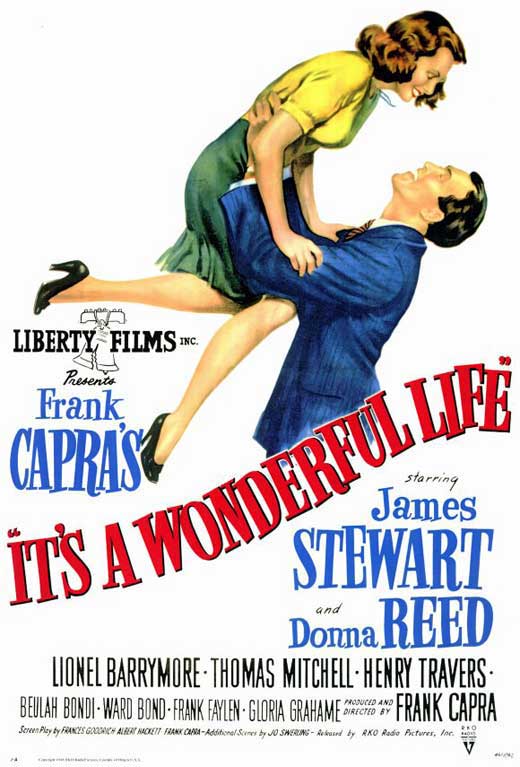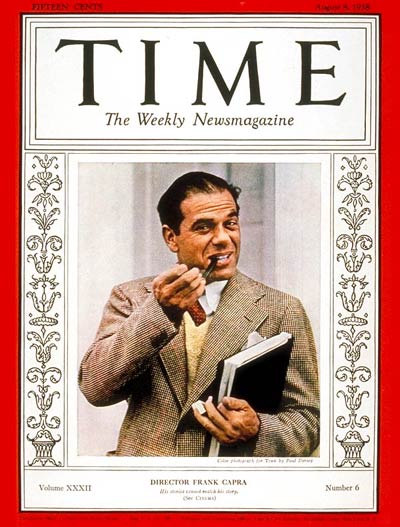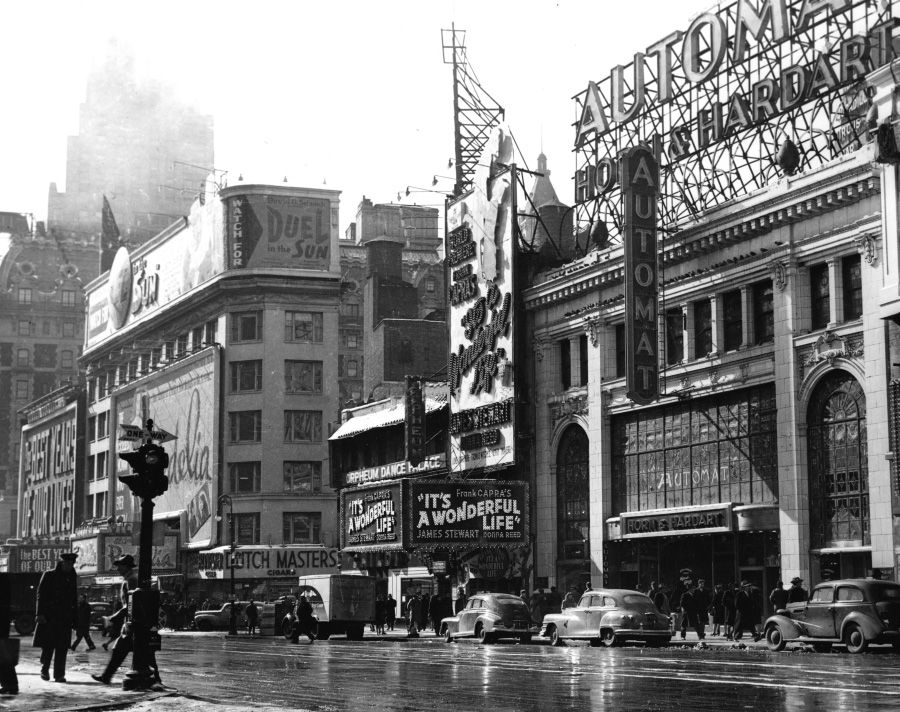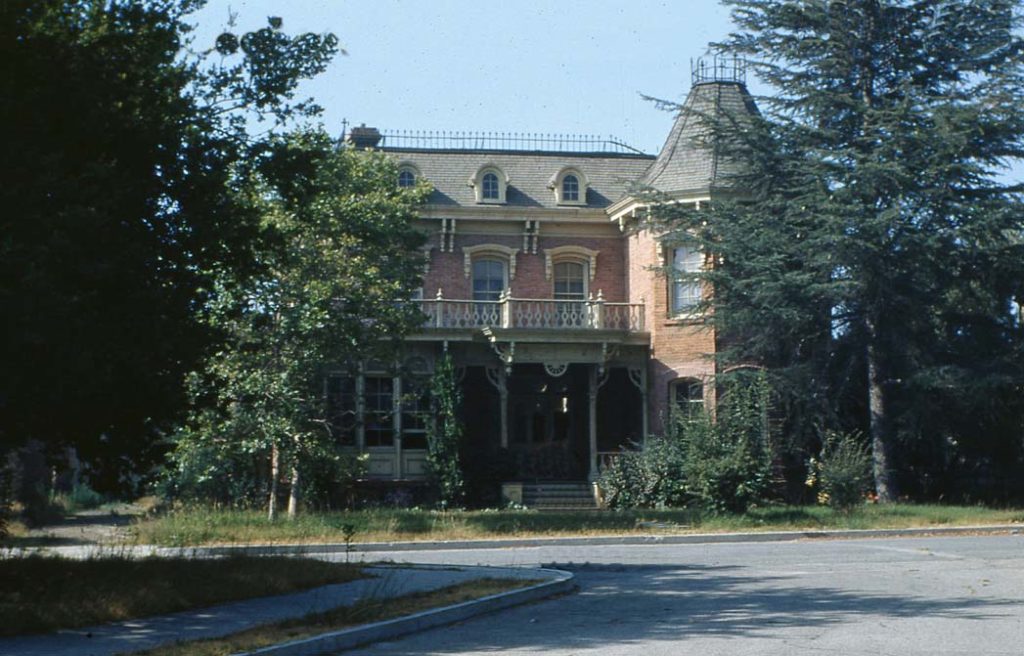AFI 12-IT’S A WONDERFUL LIFE

It’s A Wonderful life has one of the most interesting histories of any film I know. I first saw the film on a New York City afternoon TV showing—I don’t recall the station—where a considerable amount of material was cut to fit into a two hour time slot and of course I had to sit through endless commercials. If my memory serves this was in the late 50s. At the time I wasn’t particularly impressed and thinking back thought it was just another Jimmy Stewart movie. I may have watched it one or two more times on TV after that but I don’t have a clear memory of those showings. It was not a film I sort out or went out of my way to catch.
Then while I was in college I read Frank Capra’s hugely popular—and also quite embellished—career memoir The Name Above The Title. It’s a wonderful book and as Capra was a wonderful story teller he used the book to weave a wonderful if not altogether accurate look at his movie career when he was one of Hollywood’s most successful directors. The title of the book comes from the fact that Capra was one of the few directors whose name above the title—where stars names usually went on marquees—could draw in audiences.
In the book Capra wrote about his many films but the section on A Wonderful Life proved a revelation. To tell you the truth until I read the book I didn’t even realize that Wondeful Life was a Frank Capra movie. In addition, I also learned that it was not only his first film made after the war and his return to Hollywood after being in the Armed Forces but it was an independent movie made by Liberty Films, a company that Capra, George Stevens and William Wyler had set up so that they didn’t have to deal with Studio interference.

As these were three of the most successful as well as independent directors in Hollywood, it didn’t take them long to find financing and make films their way for their company releasing through RKO. Capra made two—with State Of The Union made for MGM. George Stevens made one film—I Remember Mama—but Wyler was involved in The Best Years Of Our Lives and didn’t get around to making a film for his company. Liberty didn’t last long as the three filmmakers could make films but didn’t have the foggiest idea of how to run a film company. Eventually the company was sold to Paramount which bought it because along with the company they also bought a three picture commitment from each of the directors from which the three would pocket a great deal of money.
In addition to not knowing how to run a company the films made for the company really didn’t do that well With A Wonderful Life being a disappointment as it was made by Capra whose films had always had been massive hits. It cost nearly $4,000,000 and lost $5,000,000. (Nevertheless it was nominated for six Academy Awards—including Picture, Director, and Best actor—but won none and the reviews were mixed.) A Wonderful Life opened in—I think December 1946—as RKO’s high budget spectacular Sinbad The Sailor was delayed and, so, Wonderful Life took over the former film’s first run playdates.

No one was more surprised by the film’s “failure” than Capra as he had put so much effort into this movie and it meant so much to him. In fact, when Capra moved over to Paramount—he had become so disenchanted with filmmaking—that he quickly knocked off three pretty forgettable films, pocketed all that money and didn’t make another film for almost 10 years.
After reading Capra’s book I wanted to see the film again but for some reason it just wasn’t available on TV. But in the early 70s there was a wonderful PBS show called The Men Who Made The Movies directed by critic Richard Schickel which was a series of 10 one hour episodes. Each episode was devoted to a particular director and Capra was one of them. He was still alive at the time and so was interviewed for the show. When It’s A Wonderful Life was discussed Capra elaborated on what went into making it and his feelings about the film. The program’s narrator called the film a forgotten masterpiece. I must tell you that this impressed the hell out of me and made me want to see the film even more. (OF Note is the fact that The Men Who Made The Movies has been updated with “The Forgotten Masterpiece” now deleted.)
Then, in the mid-70s when I was editing an entertainment newspaper my first wife and I were invited to a special screening for “media” by either the Library of Congress or the National Archives, I forget which. Obviously they wanted us to write about the film that they were showing which just happened to be—irony of irony—It’s A Wonderful Life.
Before the screening someone announced that the film was being shown to us in the hopes that we would spread the word about it. He also told us that we would be watching an original nitrate print but apologized because one of the reels were damaged and an acetate reel would be substituted. So, that said, on came the film.
First of all, if you haven’t seen It’s A Wonderful Life in a nitrate print, you just haven’t seen the movie. Nitrate has this—for lack of a better word—golden glow to it that is incredible. This became even more obvious when that acetate reel came on.
Second, what TV commercials did and does is dilute the real power of the movie. It’s a wonderful life is the work of a master filmmaker at the height of his powers and in complete command of the medium. But it must be seen without distraction as it was created to slowly and carefully build through both the story thorough audience identification. Therefore, any disruption detracts from the film’s intended impact. Consequently, the screening was revelation and I could now see for myself what Capra and that documentary were discussing. It was a masterpiece and I believe then and now both Capra’s best and most successfully realized film.
Third, if you haven’t see this film on the big screen, again, you haven’t seen this movie. It serves pulls to you into that story and takes you on the journey of this man’s life that is totally involving. You are there with him feeling what he feels; joy, disappointment, love, fear an much more. And, on the big screen it becomes obvious how beautifully it was filmed. Shot after shot is a demonstration of how really great B&W filmmaking can be.

THE BAILY HOUSE IN COLOR
(I also learned—and I can’t believe I didn’t know this—but the music was written by one of my favorite Hollywood Composers, Dimitri Tiomkin. It is one of his most gentle and least bombastic scores. And for Tiomkin, that is saying something.)
After the showing—the film runs 131 minutes and although the DVD is listed at 118 the Blu-Ray is complete—my wife was actually physically exhausted. She looked at me and said “It just pulls you in and experience the emotions that these people experience. It’s just overwhelming emotionally.”
I couldn’t have put it better myself. The movie tears you apart. What I said to her was that it makes me think, “Who am I to complain. We are alive, healthy, educated don’t need to worry about money. It’s true, we do have a wonderful life.” It’s as universal a story as ever there was.
Then something happened to the film that no one expected. Because the film was made by Liberty Films, an independent company that was long gone, no one renewed the copyright and so it expired in 1974. It’s A Wonderful Life had been purchased in 1955 and then sold to another company and got stuck in a television package and so a technical error occurred and the film was considered public domain. Consequently, since no one was thought to own the film, local TV stations if they had a print could run it for nothing. And that’s exactly what they did. Starting in the mid-70s, mostly around Christmas, the film was run over and over and over.
Eventually, the owners of the film regained ownership because it was adapted from a story that was still in copyright and now NBC presents it every Christmas in special showings. But by that time the film had been shown repeatedly on local TV stations all over the country for 20 years. As they say, the genie was now out of the bottle.
So, because of those ubiquitous viewings during the 70s, 80s and 90s everyone has pretty much seen this film—I mean for a few years there, it was unavoidable—and it not only found an audience but people absolutely fell in love with the movie so much so that is now considered one of Hollywood’s great classics. In other words the film found a life of its own and on its own as this “lost Masterpiece” ceased to be lost and is now treasured.
I have seen the film on small screen TV with commercials and on Blu-Ray on a large screen TV. Neither have re-captured the experience that I had watching it on a Nitrate print in a theater. But the Blu-Ray on large screen is the next best way to see it.
As for the small screen with commercials which is how the film found its vast audience it becomes very interesting. The almost exhausting impact of the film—which might have contributed to it’s failure in its theatrical run is dissipated and it is not so draining. Thus you are not so involved empathetically with the characters but see them almost at a distance. As a result the film becomes lighter and easier to take and the message that it wants to tell easy to digest. The theme—which is a beautiful one—comes across in a more upbeat manner.
There have been several books written about the making of the film so if you want to learn more about that I suggest you do a quick search of Amazon. You won’t be disappointed.
I could go on about the cast but why bother. It is perfect and Jimmy Stewart considered it his best performance and I tend to agree
Is it a great movie….that is questionable. Is it a wonderful movie? That goes without question? It’s a film that has real heart and after watching you will actually feel better about yourself. It affirms life and you can’t get much better than that.